Local search engine optimization is simple in theory. It’s how businesses improve their online presence specifically for local target audiences.
In practice, this isn’t as complex as you might think, partly because Google is refreshingly clear about local SEO ranking factors (more on that later).
But to help bring even more clarity to this subject and guide your future SEO efforts, we’ve compiled what is possibly the most useful list of local SEO tips to date along with detailed explanations for each.
These are our 7 local SEO tips:
- Prioritize and optimize GMB.
- Update all NAP(+W) listings.
- Solicit and respond to customer reviews.
- Focus on ongoing optimization.
- Be proactive with your Q&As.
- Keep technical SEO top of mind.
- Pay attention to the competition.
Why local SEO is so important
Nearly half of all Google searches are local queries. People search Google for what products or services are near them, and you want your company’s website to be on Page 1 of the list of results. That requires geo-targeted web content.
For instance, there’s a big difference between asking Google how to install a lightbulb and where in Boston’s North End you can buy a lightbulb. For the latter query, Google needs to know:
- That your company is in the North End (proximity).
- That you sell light bulbs (relevance).
- That you’re the best at selling light bulbs (prominence).
Local search engine engine optimization is about giving Google the information it needs to determine that your business is the most proximate, relevant and prominent product or service.
An embarrassment of riches lies in wait if you succeed. Just consider the influence local search has on bringing in new business:
- 82% of smartphone shoppers conduct searches using the words “near me.”
- 72% of consumers who conduct a local search visit a store within 5 miles.
- 50% of mobile users who conduct local searches visit the store within one day.
The top ranking signals
The top ranking factors for organic local SEO, according to Moz, are:
- Link signals: 27.94%
- On-page signals: 26.03%
- Behavioral signals: 11.5%
- GMB signals: 8.85%
- Citation signals: 8.41%
- Personalization: 7.32%
- Review signals: 6.47%
- Social signals: 3.47%
Note that these are types of signals, and not the specific signals themselves.
Also, I promise that these will make more sense as we go on. But at a basic level, all you need to understand right now is that, if your local SEO strategy nails all of these, you greatly increase your website’s chance of landing on Page 1 of local searches that are relevant to your brand.
With that in mind, there is one thing better than being on the first page, and that’s being in Google’s Local Pack (aka, the 3-Pack, or the Map Pack). This refers to the top-three businesses that appear on a local search:
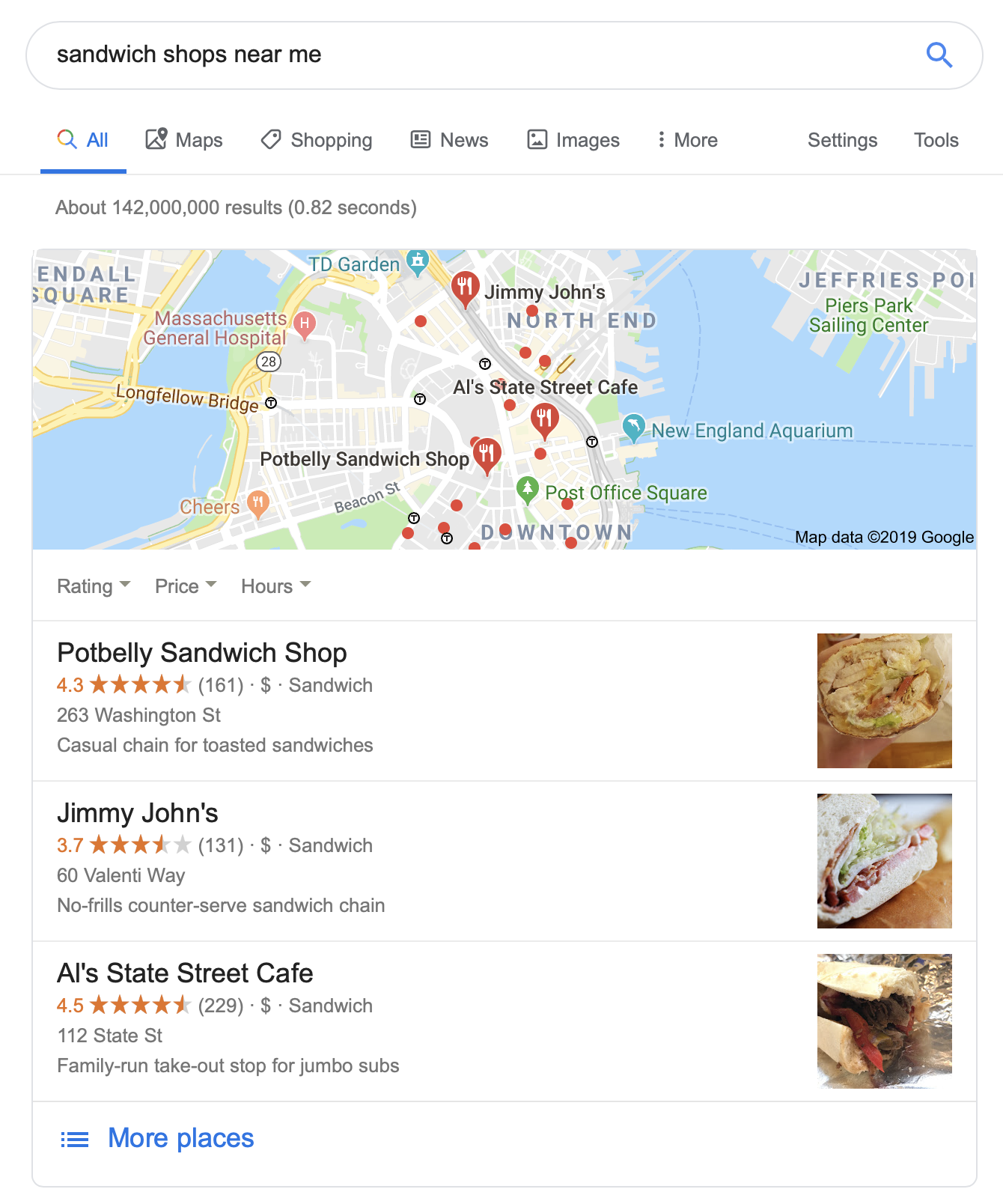
Conveniently, Local Pack uses the same combination of key ranking factors as organic local SEO, just in a different order:
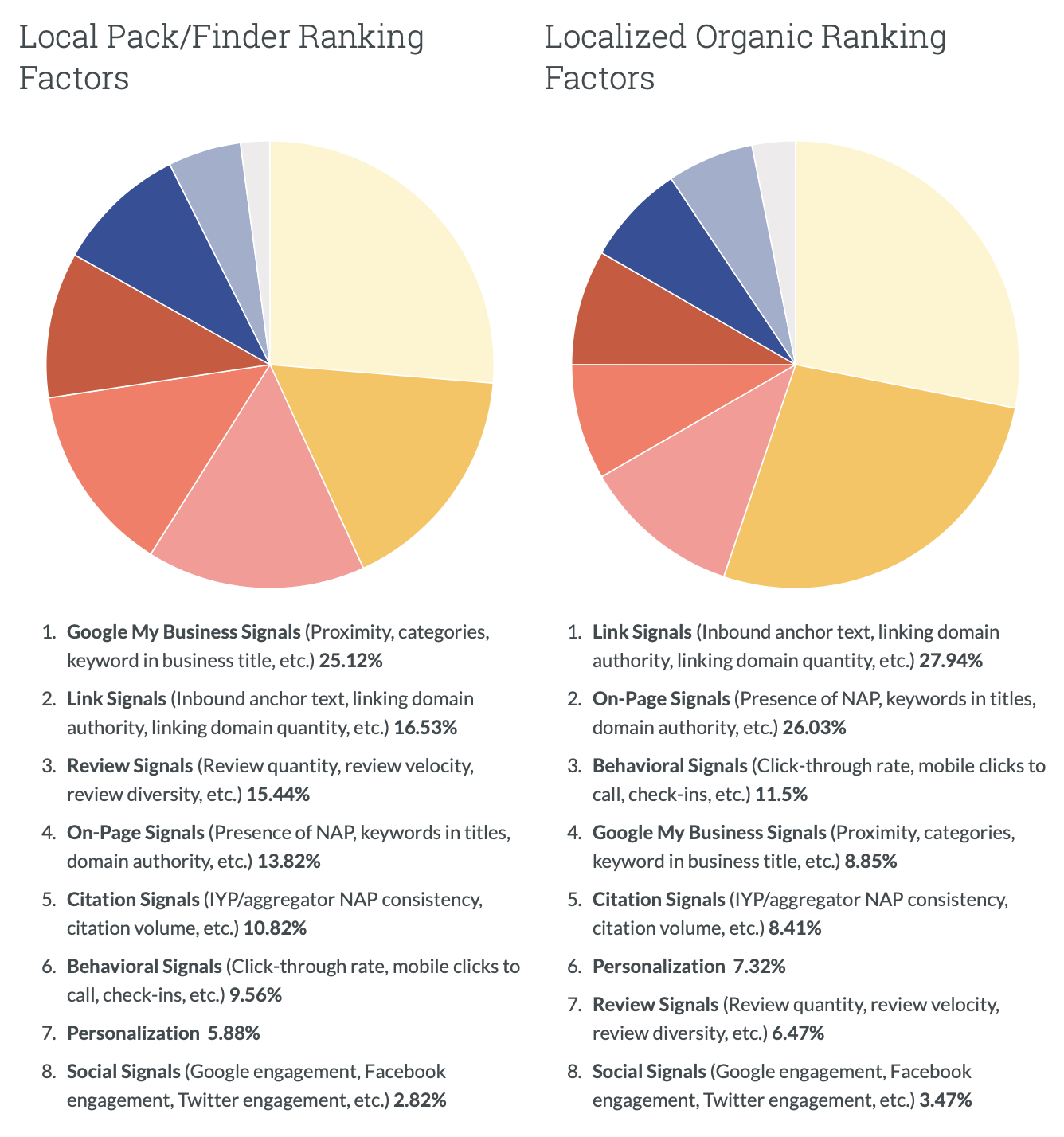
A note on mobility
By default, Google uses the mobile version of a webpage as the primary version. This is reason enough to create a mobile-friendly website, but the stakes are even higher as far as local SEO is concerned. According to Moz, “Mobile-friendly/Responsive Website” is the fifth most important ranking signal.
As we pointed out earlier – the overwhelming majority of smartphone users conduct “near me” searches. What’s more, 82% of searchers use their mobile devices to help them make in-store purchasing decisions.
It’s worth adding that local SEO is surprisingly important in voice search: 75% of smart-speaker owners search for local businesses at least once a week. This isn’t necessarily actionable information (although you can learn more about voice search ranking factors here if you want) – but it will be worth keeping in mind if and when voice search becomes more popular.
Local SEO tips from the experts
Now that you’re familiar with some of the basics of local SEO, let’s dive into tips:

1. Prioritize and optimize GMB
GMB stands for “Google My Business” and it is the tool for getting your business listing on Google. Think of it as a one-stop shop where you can:
- Claim an existing listing for your business (say, if a customer created a listing for your business to leave a review).
- Create a new listing for your business (keep in mind that you can create multiple local listings if you’re a multi-location business)
- Manage reviews, Questions and Answers.
- Add name, address, phone number and website (NAP+W), as well as operating hours, photos, videos and Google Posts.
“Claiming” each of your locations’ GMB profiles and making sure all of the basic business listing information (NAP, business description, map location, etc.) is correct is just the beginning,” Krystal Taing, Local Product Strategy at Rio SEO, advised. “Don’t stop with the basics! Google now enables businesses to include menus, define service areas, create different types of Posts, and more inside each GMB dashboard.”
By “Posts” Taing is referring to “Google Posts.” These are essentially micro-blog posts that you can add to your business listing. Event promotions, deals, coupons, company updates, recent brand news and links to a booking site are examples of Google Posts. According to Moz, quantity of Google Posts is actually a local SEO ranking factor – No. 21, to be precise. They’re a great way to get content on the first page of SERPs for queries that include your business’s name.
The bottom line: Take Taing’s advice, and optimize your GMB listings with up-to-date information, but also useful content that will help retain searchers’ attention.
2. Update all NAP(+W) listings
NAP(+W) stands for name, address and phone number plus website. Local customers need this information to learn more about your business, get directions through Google Maps or perform click-to-call via a mobile device.
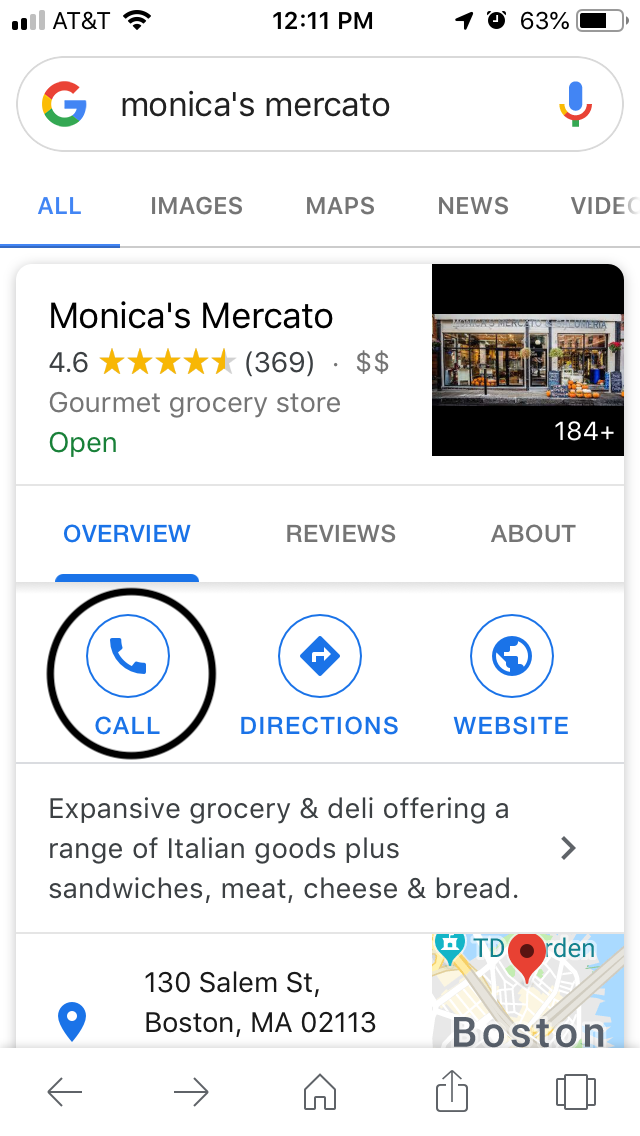
Every time another website or business directory lists your NAP(+W), your business earns a citation. Generally speaking, more citations are better, which is why you should list your company in as many relevant online directories as possible.
Top online directories to list your business for local SEO:
- Better Business Bureau.
- Yelp.
- Facebook.
- Foursquare.
- Yellow Pages.
- Apple Maps.
- Yahoo!.
Citations can also come from industry magazines or local news sources.
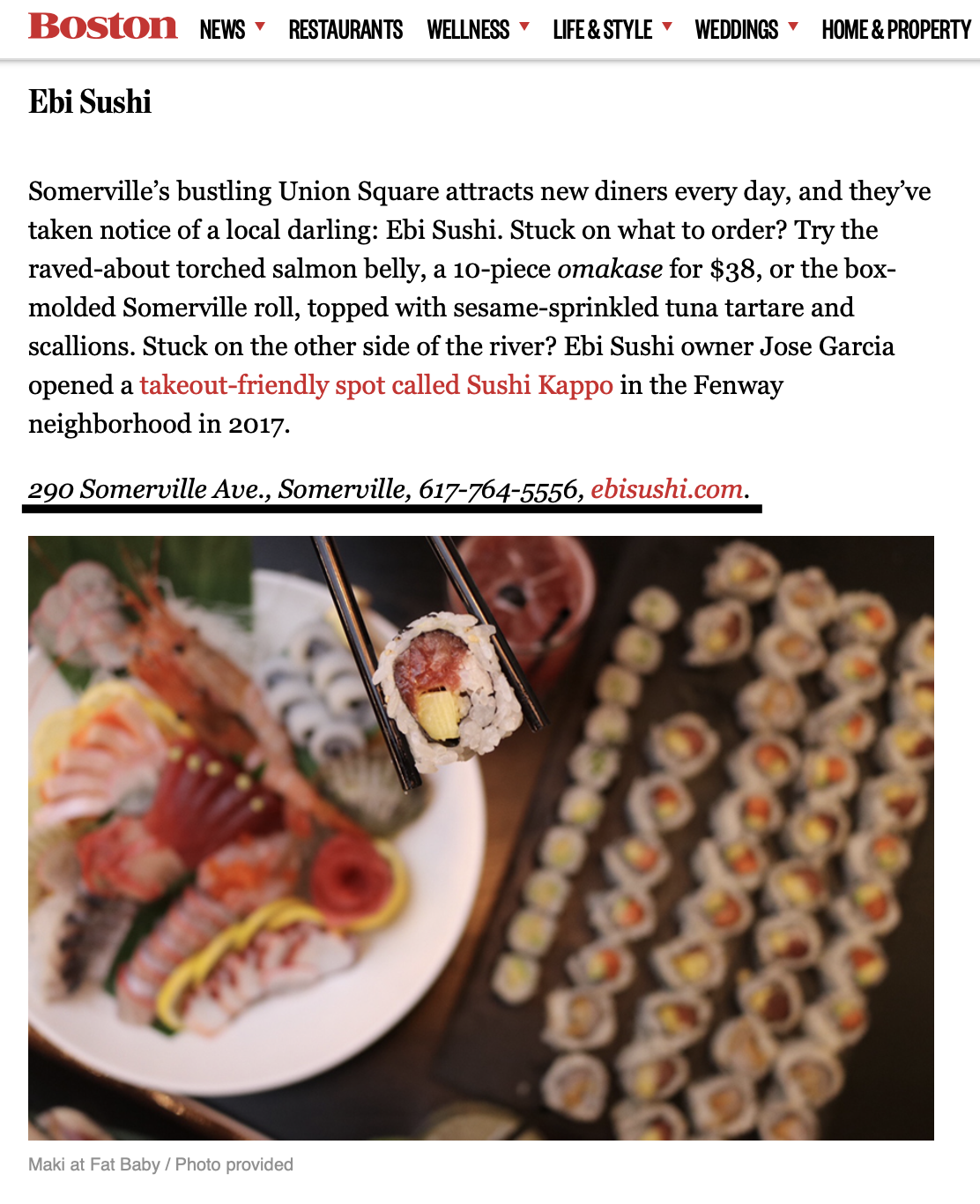
But when inaccurate or inconsistent information about your business is posted to local directories, your business page could face a ranking penalty.
“Google Maps is based on structured data from local directories, data aggregators and enterprise websites, and looks for consistent information about facts related to local entities (businesses),” Bill Slawski, Director of SEO Research at Go Fish Digital, told Brafton. “That is why Google values NAP (name, address, phone) consistency from those sources.”
Google also cares about the quality of the citation – e.g., the domain authority of the citation. This means that an inaccuracy in Yelp, for instance, would do a lot more harm than poor information on a personal blog with low DA. Keep in mind that other info such as hours of operation also factor into citation signals.
The bottom line: Keep your NAP(+W), business hours and other company info up to date and consistent on GMB, but also on other business directories.
3. Solicit and respond to customer reviews
As many as 97% of consumers read online reviews before spending money on a product or service. Your business is responsible for cultivating this powerful source of referrals and social proof by encouraging satisfied customers to rate you online.
Quantity and diversity of product reviews are also search signals. Simply put, you want more reviews, and for the purpose of getting more calls, read-throughs and scrolls (all of these are also search signals), you want them to be useful to potential customers and, ideally, positive.
Every review is also a chance to continue your conversation with the customer. For example, you can demonstrate top-notch service with tactful responses to negative reviews. A little bit of graciousness also goes a long way.
“You should respond to all your customer reviews – even if you’re just thanking them for the review,” Bill Hartzer, CEO of Hartzer Consulting, advised. He added: “Try to work some of your keywords into the response, as well.”
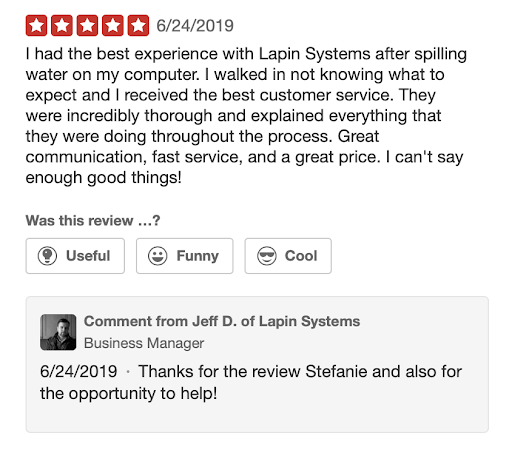
That’s right – product/service keywords in reviews is also a ranking signal, and an easy one to take advantage of simply by responding to customers. Just make sure any inclusion of keywords in comments feel organic, and – whatever you do – don’t overstuff them. Google might interpret this as spam.
The bottom line: Online reviews improve your business’s visibility on local search, demonstrate that you care what customers think and improve keyword rankings (just avoid keyword stuffing).
4. Focus on ongoing optimization
One of the most interesting pieces of local SEO advice came from Philip Rozek, Owner of Local Visibility System, aka “the last SEO guy you’ll ever need.”
“Distinguish the one-time work from the ongoing work, and don’t keep working on the former and putting off the latter,” Rozek said. “The one-time local SEO work mainly consists of (a) creating and/or correcting your listings on various local-business directories, and (b) basic website optimization, like creating an in-depth page on each specific service you offer and putting plenty of info about your services (and service area) on your homepage.”
He added: “Most of your ongoing work should center on (a) earning links from relevant sites and on (b) asking customers for reviews.”
Most of your ongoing [local SEO] work should center on (a) earning links from relevant sites and on (b) asking customers for reviews.
This is all good advice worth a closer look – starting with website optimization.
Click-through rate from search results is in Moz’s top-10 local SEO ranking factors. To earn more clicks via search, you’ll need to rank for more keywords. Start by creating static landing pages that target specific keywords important to your brand. Make sure you also include your most important keywords in your GMB listing.
For ongoing on-page optimization effort, blog on a regular basis and develop other on-site content that incorporates long-tail keywords. This will increase the breadth of keywords that your brand ranks for and improve search visibility.
Rozek also touched on “earning links from relevant sites,” – the importance of which cannot be overstated. As you may remember, link signals – e.g., backlinks and the quality of the source of those inbound links – are the top ranking factor for local SEO.
This refers to any links to your site through business directories, but also links from:
- Social media (social signals are also a thing).
- Reviews and press – for instance, local news might link to events and deals.
- Magazines and bloggers who reference your online content as a source of authority in their articles.
The bottom line: As part of your ongoing local SEO strategy, create web content that targets local keywords, try to earn backlinks through multiple online channels (including social) and solicit customer reviews.
5. Be proactive with your Q&As
Whether or not you know it, your business listing on Google has a question and answer section, and if you’re not attentive to it, things can go south.
“For many enterprises, Google Questions and Answers are one of the biggest brand hazards on the internet,” David Mihm, VP, Product Strategy at ThriveHive and founder at Tidings, cautioned.
Why? Mainly because anyone can answer the questions asked here, creating a potential situation where incorrect information prevents customers from visiting.
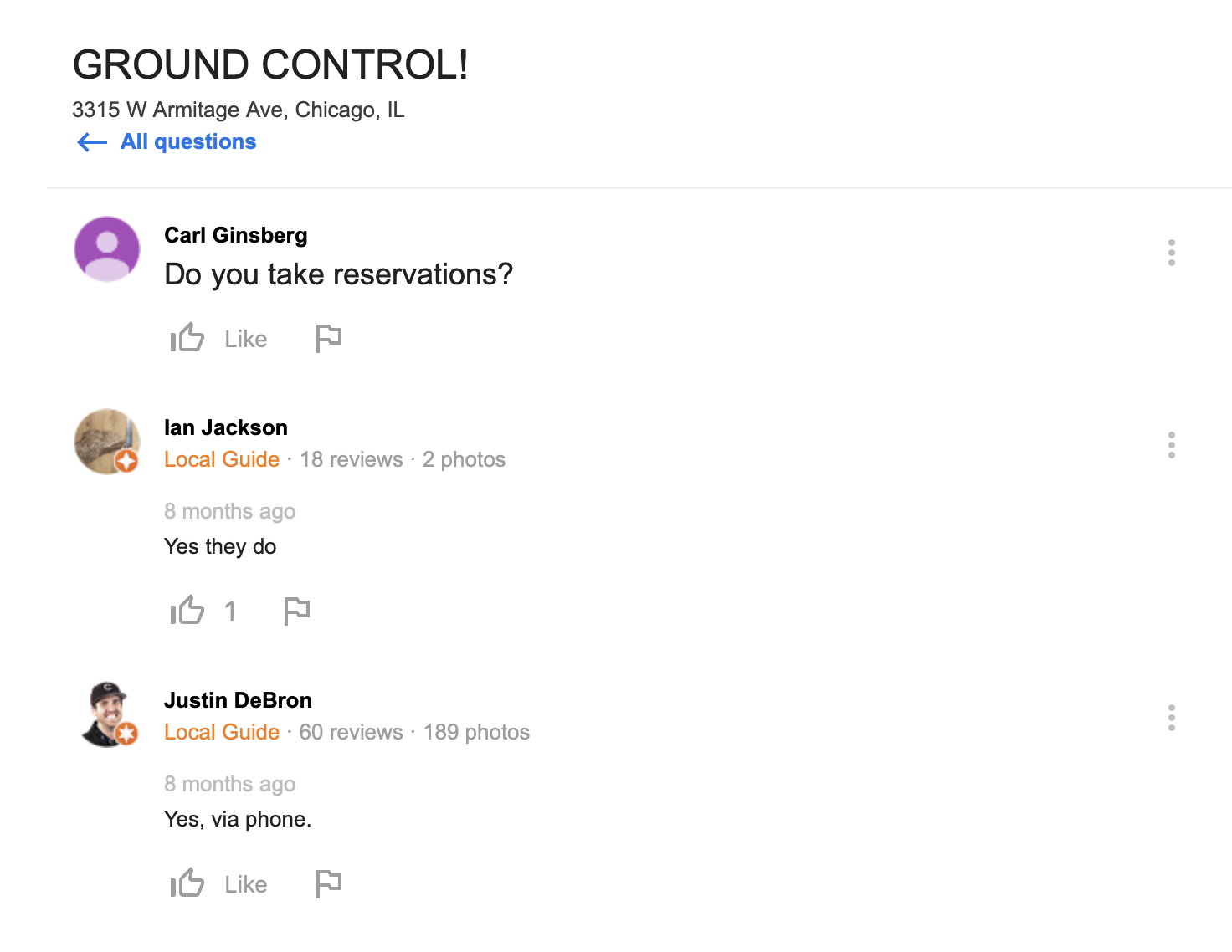
Mihm’s advice for resolving this problem makes a lot of sense:
“If you don’t yet have (m)any public questions, get a head start by posting and answering your own FAQ,” he said.
Otherwise, if you do spot bad information, it’s fairly easy to remove it. First, find the “flag” icon:
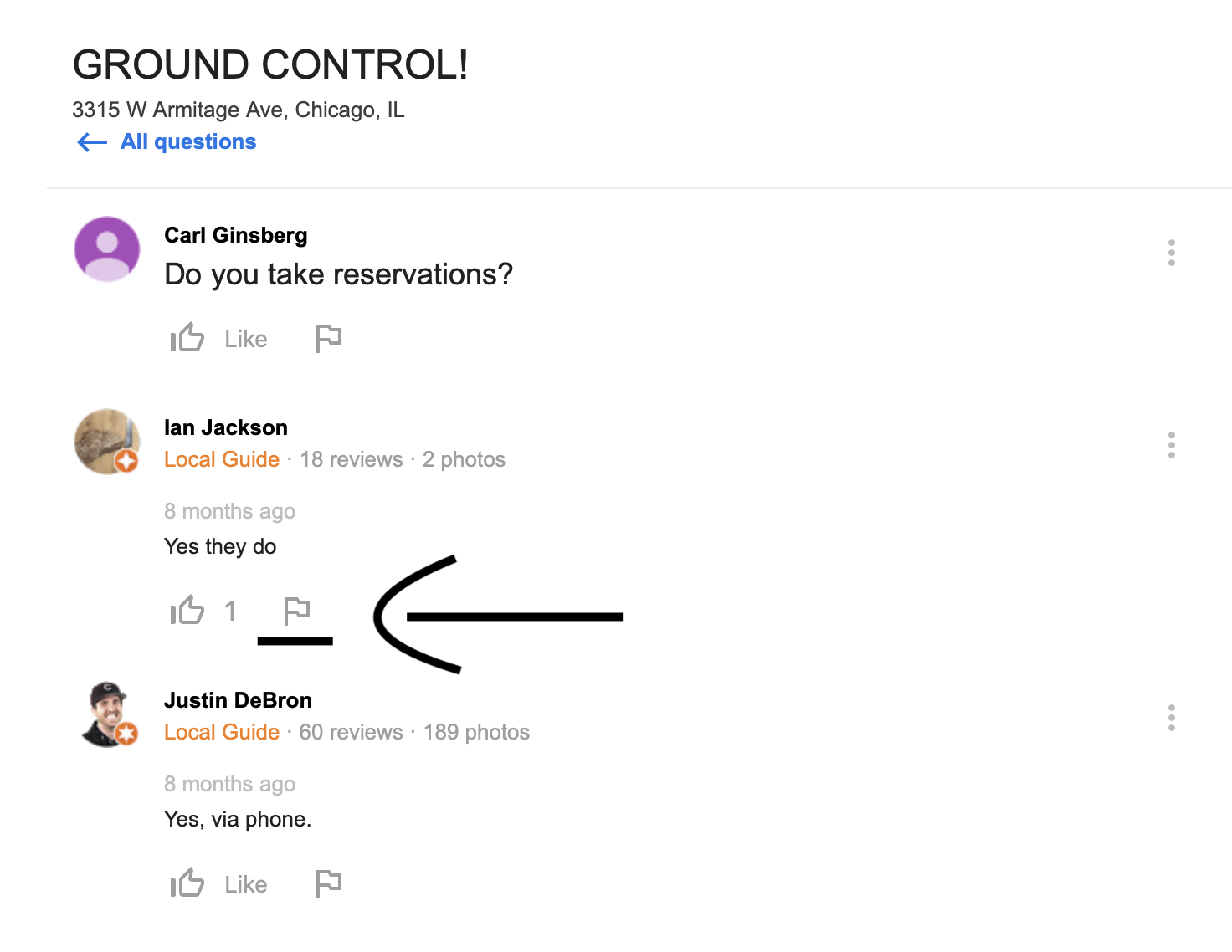
The rest is pretty self-explanatory:
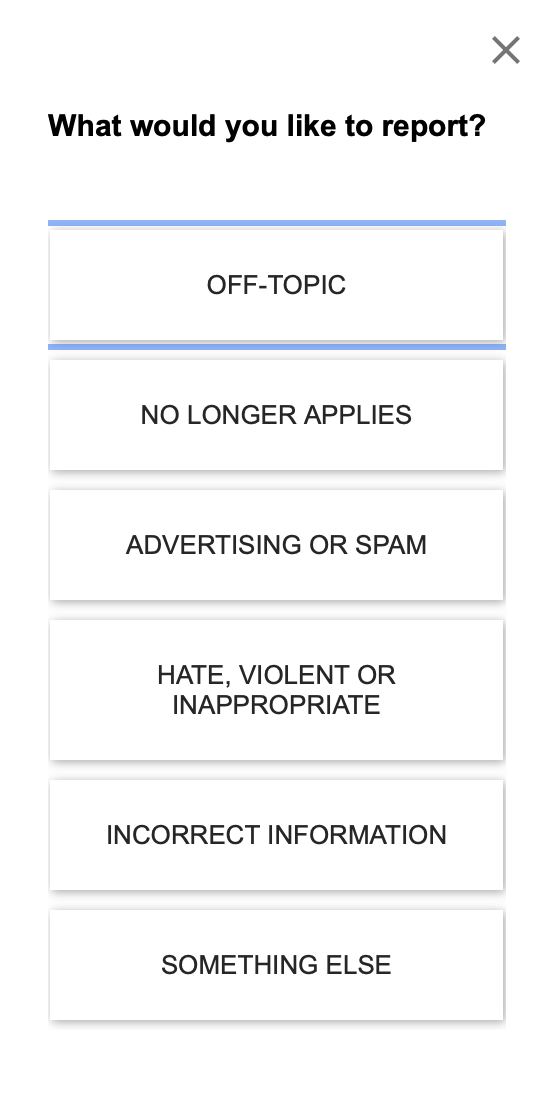
If Google doesn’t remove the comment, you may have to contact the GMB support team. In general, it’s best to avoid these types of situations by trying to answer questions before someone else speaks on your brand’s behalf.
The bottom line: Love them or hate them, Q&As are here, and it’s in your business’s best interest to make the most of them.
6. Keep technical SEO top of mind
Our expert Mihm also had a thing or two to say about technical SEO, starting with this advice to businesses that have multiple locations:
“Ensure there’s a unique, crawlable, indexed page per location on your primary domain,” he urged.
In other words, avoid using a fancy map locator, and instead create a page on your main site for each of your locations. There are a few benefits to doing this:
- The added value you get from the local SEO traffic that might come to the site because of those locations’ additional pages – especially if you optimize the content on those pages for relevant, geo-targeted keywords.
- You can add schema markup to those pages to tell Google that they are locations pages.
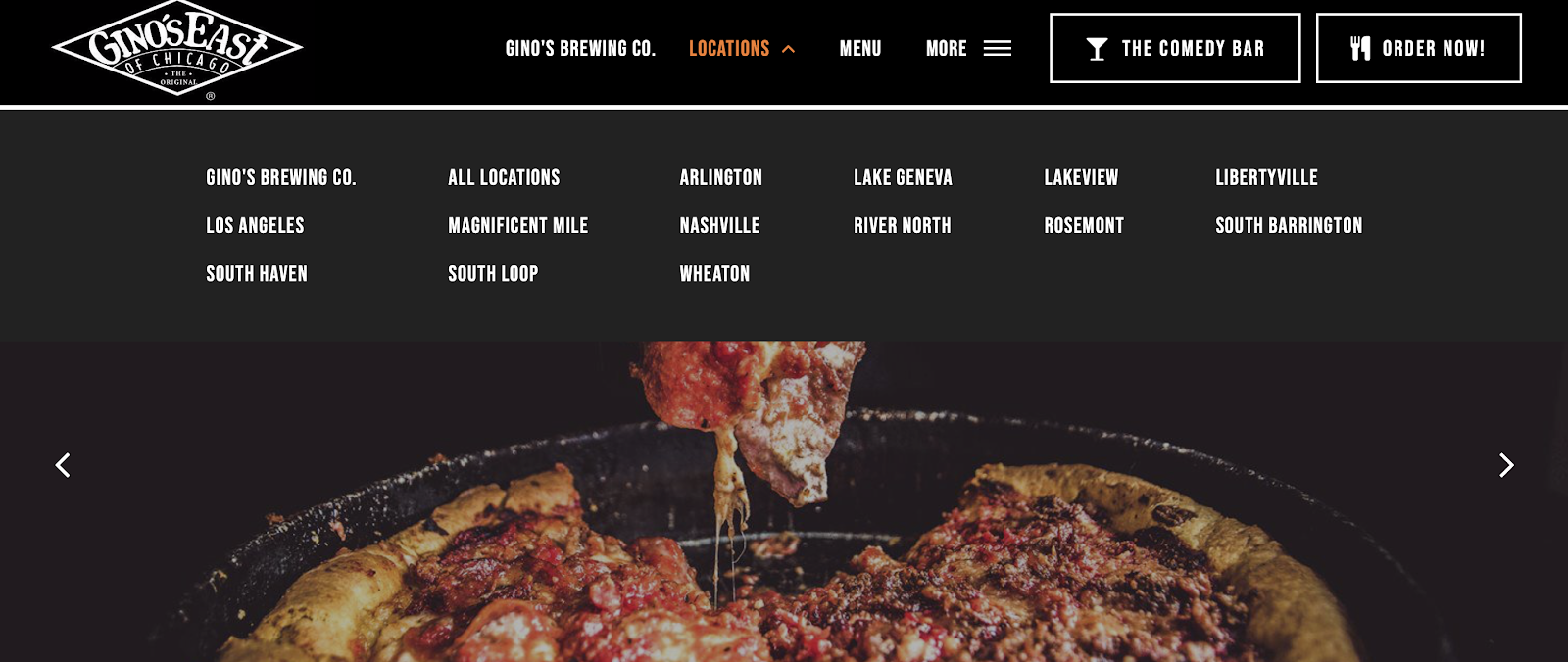
“Make the effort to deploy a traditional store directory on your primary domain,” Mihm said. “It’s the most scalable, longest-term SEO win available to large brands.”
Amy Toman, SEO Analyst at ClassyBrain, reminded us that it’s equally important to ensure information is easily accessible by a human audience as well.
“What is your business’s most important information that clients seek? For storefront businesses, it’s probably your address. For service-area businesses who travel, it’s probably your service area,” she explained.
“That information needs to be prominently placed on your site, and easy to find. I’ve had the most success with placing addresses in the header, footer, contact pages, and for service-area businesses, on a service area page.”
The bottom line: Optimize your site layout – backend and frontend – in a way that’s advantageous to local SEO.
7. Pay attention to the competition
Our final tip comes from Niki Mosier, Technical SEO Manager at Seer Interactive.
“Pay attention to the competitors. Keep an eye on the search results and see who is ranking above and below you,” Mosier said. “Report or make edits to competitor Google My Business listings that are using spam tactics in their listing, like keyword stuffing the title or inaccurate categories.”
No one wants to be a snitch, but in this case, it’s just good business. Google does what it can to catch black-hat SEO tactics such as keyword stuffing and spamming, but there are workarounds. If you suspect foul play among a top competitor, you can file a report here.
Technical #SEO folks. What questions do you have about #LocalSEO? Working on a slide deck and would love your input! Thank you in advance!
— Niki Mosier (@nikers85) March 11, 2019
While you’re at it, keep an eye on industry trends. This will help you spot opportunities to highlight trendy value props that your business delivers, and add Q&As around those trends.
The bottom line: How you fare in local markets is highly dependent on what the competition is doing and what’s happening in your industry – so pay attention.
And there you have it.
Seven experts, seven tips, and everything you need to start making your brand more visible to customers near you.
Oh, and while you’re here, feel free to share some expert local SEO advice of your own in the comments section below.





